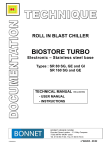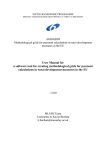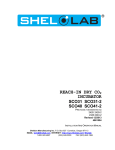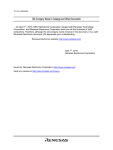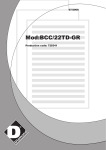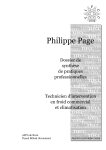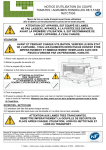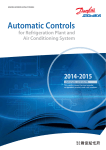Download BIOTRONIC TURBO - Telenet Service
Transcript
9 ROLL IN BLAST CHILLER BIOTRONIC TURBO Electronic Regulation Types : R80, R160 External refrigeration unit R80 Incorporated refrigeration unit TECHNICAL MANUAL INCLUDING - USER MANUAL - INSTRUCTIONS BONNET GRANDE CUISINE Rue des Frères Lumière - Z.I. Mitry Compans 77292 MITRY MORY cedex Tél. 01 60 93 70 00 - Fax. 01 60 93 70 43 FORM050B1/1 n°648257 - 04/00 RECTO USER MANUAL ROLL IN BLAST CHILLER BIOTRONIC TURBO Electronic Regulation Types : R80, R160 with or without external refrigeration unit R80 Incorporated refrigeration unit CONTENTS Important recommendations 2 1. Use of the control panel 3 2. Use 10 3. Maintenance 11 BONNET GRANDE CUISINE Rue des Frères Lumière - Z.I. Mitry Compans 77292 MITRY MORY cedex Tél. 01 60 93 70 00 - Fax. 01 60 93 70 43 User Manuel n°648257 - Page 1 IMPORTANT RECOMMENDATIONS ∗ This unit is designed for use in Restaurants or Catering facilities. It is not intended for industrial use. ∗ Installation should be undertaken by a refrigeration engineer. ∗ Avoid installing the unit near major sources of heat or in direct sunlight. ∗ Note that too high an ambient temperature can reduce performance. ∗ The compressor condenser must be cleaned regularly (every 3 to 6 months) by a refrigeration engineer. ∗ Do not modify the electrical connection made during installation, particularly the earth continuity circuit. ∗ The supply cable that is fitted is a specific part and should only be replaced with an original part. Ensure that the plug is easily accessible. ∗ In the event of problems with the electrical circuit, only the installer or the manufacturer should intervene. ∗ Observe hygiene guidelines by regularly cleaning the following : . interior fittings . door seal . interior lining Do not use corrosive or acidic products. ∗ Water splashing can cause damage. . To avoid the risk of splash damage, do not clean with a hose or high-pressure spray. . Do not locate the unit where it is exposed to the elements ∗ Reference to the label NF FOOD HYGIENE : certified by : AFNOR Certification Tour Europe 92049 PARIS-LA-DEFENSE Cedex – France ∗ The label NF FOOD HYGIENE complies with the NF031 requirement. The main certified characteristics are : . Cleaning qualification . Refrigerating performances ∗ If the installation, the use or the service is modified, the appliance will lose the right to use the label NF FOOD HYGIENE. SPECIFICATION AND CHARACTERISTICS IN THIS DOCUMENT MAY BE SUBJECT TO BE MODIFIED WITHOUT PRIOR NOTICE User Manual n°648257 – Page 2 1. PRESENTATION OF THE CONTROL PANEL 1.1 IMPORTANT Stop of the unit does not cut the power supply to the appliance. If the appliance is not to be used for a period of time, power must be cut off with the insulation switch located on the control panel’s side, the plug or the disconnector because of the risk of dammaging the refrigerating equipment. 1.2 KEYBOARD DESCRIPTION Defrost cycle and/or Prefunction cycle Timer cycle Core probe cycle Display - Temperature - Time (h.mn) - Coded defect Fragile products On/Off switch End of cycle indicator (storage) Defect Cycle start (validation) Cycle indicator For the use of the keyboard, see : - SIMPLIFIED GUIDE (paragraph 1.4 page 5) - DETAILED GUIDE . Start . Cycle with probe . Cycle without probe (Timer) (paragraph 1.5) (paragraph 1.5.1 page 6) (paragraph 1.5.2 page 7) (paragraph 1.5.3 page 8) - SPECIAL SETTINGS (paragraph 1.6 page 9) - ALARMS AND DEFECTS (paragraph 1.7 page 10) User Manual n°648257 – Page 3 1.3 GENERAL RECOMMENDATIONS 1.3.1 DEFROST, PREFUNCTION CYCLE Before loading products, a prefunction cycle should be launched in order to cool the interior of the appliance. It can be launched automatically when the appliance is powered up, by modifying the factory settings (see ‘instructions’). Each prefunction cycle is automatically preceded by a defrost cycle. If needed, this function can be stopped (see paragraph 1.6 ‘Special settings’). During the defrost and/or the prefunction cycle, the display indicates the ambient temperature of the appliance. Defrost is made with a weak ventilation. It can be made with a strong ventilation by modifying the factory settings (see ‘instructions’). After loading products into the appliance, choosing the chilling cycle at the closing of the door can be made compulsory by modifying the factory parameters (see ‘instructions’). 1.3.2 REFRIGERATION CYCLE WITH CORE PROBE It is recommended to use the core probe whenever it is possible and in particular for a chilling cycle because it automatically controls the cycle. The 5 points core probe allows to read the hotest point at the heart of the product. The cycle ends when the hotest sensor reaches the required temperature (factory setting = +10°, which can be modified case by case). The display alternately indicates the temperature at the heart of the product, and the remaining duration of the cycle. With the factory settings, a core probe insertion test indicates that the probe is not used for a hot product ( sound alarm and the indication SP is displayed). 1.3.3 REFRIGERATION CYCLE WITH TIMER When the use of the core probe is impossible, a cycle with timer is possible (factory setting = 120 mn, which can be modified case by case). The cycle programming time depends on the type and the quantity of food to be cooled. During the cycle, the display indicates the remaining duration. 1.3.4 VENTILATION To avoid water spattering on the products, the ventilation power is automatically controlled by the temperature of the appliance, with a factory level pre set at 12°C. 1.3.5 ‘FRAGILE PRODUCTS’ FUNCTION In some cases, it is possible to refrigerate the products avoiding frost deposit (antifreezing function). This function should only be used for reduced quantities of products. After selecting the cycle with core probe or with timer, press "Fragile Products" key. In this case, the cycle will operate following the factory settings with an air temperature superior to -15°C with a strong ventilation. This can be modified case by case whenever it is needed ; for example, a weak ventilation can be applied for light products (see paragraph 1.6 ‘Special settings’) 1.3.6 PRESERVATION AFTER THE CYCLE At the end of each cycle, the appliance programs automatically the preservation to a temperature of +3°C with a weak ventilation, following the factory settings. The display indicates the ambient temperature. The storage duration inside the appliance can be unlimited thanks to an automatic control of the defrost during the preservation cycle. User Manual n°648257 – Page 4 1.4 SIMPLIFIED GUIDE with factory settings POWER UP Press Press for a few seconds. ) PREFUNCTION CYCLE Press To select the cycle Press ) to launch the cycle. A defrost cycle is launched and automatically followed by a prefunction cycle. LOADING At the end of the prefunction cycle, introduce the products into the appliance. For a core probe cycle, introduce the core probe deep inside the product. CYCLE WITH PROBE (with use of the core probe) Press To select the cycle. Sound alarm and the indication SP is displayed if the probe is not correctly used. and if necessary ) ) or To modify the temperature of the set-point at the end of the cycle. CYCLE WITH TIMER (without using the core probe) Press To select the cycle ) and if necessary ) or To modify the cycle duration FRAGILE PRODUCTS Press To limit air temperature, avoiding frost deposit. ) CYCLE START Press ) (press for a few seconds during the cycle). 1) To start a cycle. 2) To stop a running cycle (Press for a few seconds). CYCLE EXECUTION Led Running cycle. Led Preservation cycle (between 0 and +3°C) STOP OF THE APPLIANCE Press Press for a few seconds. It is recommended to let the door half-open when the appliance is not used. ) User Manual n°648257 – Page 5 1.5 DETAILED GUIDE 1.5.1 START (Prefunction cycle) 1 Power up Press for a few ) seconds 1) All the leds as well as the display light up (Microprocessor test). 2) The machine number, pre-programmed during installation lights up. 3) The ON led lights up and the temperature of the appliance is displayed. 2 Selection and start This stage can be launched automatically when the appliance is powered-up, by modifying the factory setting (parameter 03). The prefunction cycle led lights up. 1) Start of the defrost cycle with a pre set ventilation power (weak) until the temperature of the appliance is superior to the pre set temperature (5°C) without exceeding a maximum time (30mn). This function can be disactivated with the d6 parameter (see paragraph ‘Special condition’)) 2) Start of the compressor with production of cold air until the pre set temperature is reached (-15°C) Manual selection ) Press Manual launch The led indicates the running cycle and the temperature of the appliance is displayed in real time. ) Press 3 Automatic end of cycle The ‘preservation after cycle’ led lights up. The bell rings during a few seconds. The appliance moves to the preservation stage, waiting for the products to be loaded. N O T A During the cycle, press(a few sec.) ) Full and definitive stop of the running cycle. The door is open during the cycle Temporary stop of the running cycle. When the door is closed, the cycle starts again. During the cycle, Voluntary stop of the running prefunction cycle to select a refrigeration cycle (see paragraph 1.5.2 or 1.5.3) Press ) or Opening or closing the Choosing a refrigeration cycle is automatically asked. door during or after the The leds flash cycle by modifying the factory setting (parameter The bell rings until a cycle is chosen. 02) All operating parameters set in factory can be modified when needed(see ‘instructions’). User Manual n°648257 – Page 6 1.5.2 START AND STOP OF A CYCLE WITH CORE PROBE 1 Open the door and introduce the products to be cooled. Introduce the core probe as deep as possible inside the product. Close the door. 2 Selection : ) Press 3 Settings (eventual) : Press ) or 3 Start : Press The ‘cycle with core probe’ temperature of the set-point factory is displayed. To modify the end of cycle set-point. Display of the temperature in real time. The’running cycle’ led ) led lights up and the set in lights up and the temperature at the heart of the product is displayed in real time, alternately with the remaining duration of the cycle . The cycle starts with a weak ventilation power (until the +12°C level set in factory is reached), and automatically moves to strong ventilation mode until the end of the cycle (at a temperature of +10°C at the heart). 4 Fragile products : Press ) (a few seconds during the cycle) 5 Automatic end of cycle Avoid frost deposit on the products by limiting the air temperature to -15°C (with strong ventilation). This function can be set by modifying the factory settings, with a different air temperature (cc parameter) and/or a weak ventilation (F1 parameter) Attention : This function must only be used with small loads. The ‘preservation after cycle’ led lights up. The bell rings for a few seconds. The appliance moves to the preservation stage at the temperature of +3°C with a weak ventilation power. Unloading : Do not forget to take out and clean the core probe before unloading. N Opening of the door O during the cycle T During the cycle, A press (a few sec.) Temporary stop of the running cycle. When the door is closed, the cycle starts again. Full and definitive stop of the running cycle ) All operating parameters set in factory can be modified when needed(see ‘instructions’) User Manual n°648257 – Page 7 1.5.3 START AND STOP OF A CYCLE WITH TIMER 1 Open the door and introduce the products to be cooled. Check the core probe is well installed on its support. Close the door. 2 Selection : The’cycle with timer’ led lights up and the cycle duration set in factory is ) Press 3 Settings (eventual) : Press ) or 3 Start : Press displayed. To modify the cycle duration. Display of the cycle duration in real time. The’running cycle’ led ) lights up and the remaining duration of the cycle is displayed. The cycle starts with a weak ventilation power (until the +12°C level set in factory is reached), and automatically moves to strong ventilation mode until the end of the cycle (at a temperature of +10°C at the heart). 4 Fragile products: Avoid frost deposit on the products by limiting the air temperature to –15°C (with strong ventilation). This function can be set by modifying the factory settings, Press with a different air temperature (cc parameter) and/or a (for a few seconds during the weak ventilation (F1 parameter) Attention : This function must only be used with small loads. cycle) ) 5 Automatic end of cycle The ‘preservation after cycle’ led lights up. The bell rings for a few seconds. The appliance moves to the preservation stage at the temperature of +3°C with a weak ventilation power. Unloading : Do not forget to take out and clean the core probe before unloading. N Opening of the door O during the cycle T During the cycle, A press (a few sec.) Temporary stop of the running cycle. When the door is closed, the cycle starts again. Full and definitive stop of the running cycle. ) All operating parameters set in factory can be modified when needed(see ‘instructions’) User Manual n°648257 – Page 8 1.6 SPECIAL SETTINGS 1.6.1 PROGRAMMATION (the regulation is ON) 1 Access to programmation : Press simultaneously and for a few seconds Beginning of the programmation mode. 2 Selection of parameters : Press successively ) Display of the indication and or Display of the parameters one after another. Display of the parameters’ codes 3 Access to the selected parameter : ) Press Presetting display of the parameter 4 Modification of the parameter setting: Display of the parameter’s values one Press successively ) or after another Display of the parameter’s values 5 Validation of the parameter ‘s setting: ) Press Display of the modified parameter’s code Start again stage 2 to 5 for the other parameters. Restart of the system. 6 To exit programmation : Press simultaneously During or after programmation, the system restarts automatically if no key is pressed in less and for a few sec. and than 15 seconds. ) The parameters’ modifications are definitively taken into account. 1.6.2 TABLE OF PARAMETERS Code Parameters (reserved to fitter) PA Password to access level 2 Temperature parameters (read only) °C cA Core probe temperature reading °C Fragile Products interior probe set-point cc Defrost parameters Defrost at the beginning of the prefunction cycle 0 = No ; 1 = Yes d6 Ventilation parameters 0 = Weak, 1 = Strong F1 Ventilation with Fragile Products ON Printing parameters (with optional printer) Printing frequency in chilling cycle i1 Printing frequency in preservation cycle i2 Printing at the beginning of the cycle i3 Setting of the date i4 i5 i6 Time setting i7 i8 (1) mn mn 0 = No, 1 = Yes Day Month Year Hour Minute Min Max Factory -99 99 -- --55 -99 --15 0 1 1 0 1 1 0 0 0 1 1 990 0 0 60 60 1 31 12 050 23 59 5 30 1 (1) (1) (1) (1) (1) the configuration must be set during installation. User Manual n°648257 – Page 9 1.7 ALARMS AND DEFECTS Indicated by the red light and the sound alarm The display indicates the type of defects. The buzzer can be stopped by pressing the key ) 1.7.1 USE SECURITIES The core probe is not or not well introduced in the product. The door is open. The normal time is over . Supply breakdown. 1.7.2 OPERATION DEFECTS (call for the repairer) Regulation probe defect. Core probe defect. Refrigerating defect. User Manual n°648257 – Page 10 2. USE 2.1 GENERAL REQUIREMENTS Do not load products in a way that obstructs the air circulation, this is important to ensure even distribution of cold air within the cavity. When the probe is not used, it must be located absolutely on its support. When the appliance is not used, it is recommended to let the door half-open. 2.2 LOADING A space of 15 to 20 mm is required between each item to allow refrigerated air to pass around the products. The chilling depends on the weight, nature and thickness of the food, therefore it is difficult to accurately define a loading capacity. 2.3 CORE PROBE POSITION The core probe must be introduced as deep as possible in the product to be cooled. 2.4 VENTILATION To guaranty refrigerating performance, take care the fans grids and the funnel for air outlet have not been blocked up. 2.5 DEFROST WATER EVACUATION Defrost water evacuation is made with a drain trap located inside the box of the control panel or in the back of the appliance. Check that nothing blocks up the evacuation hole located at the bottom of the tank in front of the evaporator. User Manual n°648257 – Page 11 3. MAINTENANCE IMPORTANT Before any cleaning operation, ensure that the appliance is unplugged or isolated. Do not use a spray hose To avoid water spattering on the products. 3.1 STAINLESS STEEL Use warm soapy water or a non corrosive cleaner (such as Teepol or an equivalent product), then rinse thoroughly and dry. Do not use abrasive, aggressive or concentrated cleaning products. Do not use wire wool under any circumstances. Fingerprints can be removed with a cloth soaked in alcohol. 3.2 INTERIOR LINING This should be cleaned daily. Fans To ease the complete cleaning of the interior lining and to have access to the evaporator and to the expansion valve, it is possible to open the fan support sheet. RL M6-20 screws Evaporator 3.3 REGULAR CLEANING. Particularly clean the door seals. Clean the core probe whenever it is used. In order to maintain the refrigerating capacity and to ensure the longevity of the compressor, it is necessary to clean regularly (every 3 or 6 months) the condenser in the case of an air refrigerating group. This operation must be carried out by the installer. User Manual n°648257 – Page 12 INSTRUCTIONS ROLL IN BLAST CHILLER BIOTRONIC TURBO Electronic Regulation Types : R80, R160 with or without external refrigeration unit R80 Incorporated refrigeration unit CONTENTS Important recommendations 2 1. Technical data 3 2. Installation 8 3. Operation 12 4. Interventions and repairs 14 5. Electrical diagrams 16 6. Spare parts 22 BONNET GRANDE CUISINE Rue des Frères Lumière - Z.I. Mitry Compans 77292 MITRY MORY cedex Tél. 01 60 93 70 00 - Fax. 01 60 93 70 43 Instructions n°648257- Page 1 IMPORTANT RECOMMENDATIONS ∗ When installing the unit ensure that there is adequate circulation and air volume to cool the condenser and compressor. ∗ Avoid installing the appliance near major sources of heat or in direct sunlight. ∗ Note that too high an ambient temperature can reduce performance. ∗ There must be earth continuity between the appliance and the mains connections. ∗ The supply cable that is fitted is a specific part and should only be replaced with an original part. Ensure that the plug is easily accessible. ∗ The installer should ensure that the electrical connection is suitably protected by an appropriate fuse or circuit breaker (see rating plate). ∗ Ensure that the appliance is switched OFF before any intervention on the electrical or refrigeration circuits and during cleaning. ∗ The compressor condenser must be cleaned regularly (every 3 to 6 months. ∗ Water splashing can cause damage. . To avoid the risk of splash damage do not clean with a hose or high-pressure spray. . Do not locate the unit where it is exposed to the elements ∗ After any intervention ensure that the original installation guidelines are respected to avoid any form of risk. ∗ Reference to the label NF FOOD HYGIENE : Certified by : AFNOR Certification Tour Europe 92049 PARIS-LA-DEFENSE Cedex – France ∗ The label NF FOOD HYGIENE complies with the NF031 requirement. The main certified characteristics are : . Cleaning qualifications . Refrigerating performances ∗ If the installation, the use or the service is modified, the appliance will lose the right to use the label NF FOOD HYGIENE. SPECIFICATION AND CHARACTERISTICS IN THIS DOCUMENT MAY BE SUBJECT TO BE MODIFIED WITHOUT PRIOR NOTICE Instructions n°648257 – Page 2 1. TECHNICAL DATA 1.1 R 80 SG and GE Type Codes : S 100 E 01 without refrigeration unit S 100 E 05 with external unit POSITIONING The appliance must be set on a perfectly horizontal smooth and flat surface. Allow for a silicon bead on its periphery. CONSTRUCTION - Austenitic stainless exterior casing (4 sides), and interior lining. Outdoor ceiling in galvanised sheet . Polyester resin base. Insulated body - Demountable panels with assembling hook system. - Radiused interior lining base and sides. - Polyurethane foam insulation, 75 mm thick. - Thermal break between inner and outer structure. Door - Door bib water proof joint. - 3 rising butt hinges avoiding ground joint friction. - Central door closing mechanism with interior opening. - Polyethylene access ramp, 15 mm thick. - Door opening can be reversed (at the plant) TECHNICAL DATA Voltage Input power DEFROST WATER Defrost water is collected in the resin bottom. A two way drain (1) is provided at the back and at the front of the appliance (drain trap) In the case of a front draining, forecast a surface grid under the flowing. Complies with Electric Safety : EN 60 335-1 Food Hygiene : XP U 60 010 Complies with E.C. requirements : 3N~400V 50 Cycle : Without compressor : 2400 W With compressor : 8100 W Protection : Without compressor : aM 4 With compressor : aM 16 Connections: 2,5 mm2 Provide for the protection against overloads or electrical defects. The control panel of the delivered appliance without compressor includes an insulating switch, a tetrapolar and an unipolar circuit-breaker with fuse bar, and a connecting strip with contactors. The appliance with compressor is delivered pre loaded, with pressure sensitive switch, dryer, solenoid valve, sight glass, vibration eliminator, and also pre cabled with an electric box including a connecting strip, a protection circuit-breaker, a circuit breaker with fuse bar, contactor with thermal relay, voltage and defect indicator (connection between compressor and blast chiller length 5M). Refr. power Refrigerant Load Evaporator Expansion valve Defrost Connections (2) Air compressor : 5500 W at -15/+55°C : R404A : See instruction plate : Ventilated, corrosion proof : Thermostatic R404A : Forced air circulation : Suction 1"3/8, Liquid 5/8" : 6 hp Hermetic (L) 1270 x (D) 640 x (H) 570 Instructions n°648257 – Page 3 1.2 R 160 SG and GE Type Codes : S 100 E 03 without compressor S 100 E 07 With external compressor POSITIONING The appliance must be set on a perfectly horizontal smooth and flat surface. Allow for a silicon bead on its periphery. CONSTRUCTION - Austenitic stainless exterior casing (4 sides), and interior lining. Outdoor ceiling in galvanised sheet . Polyester resin base. Insulated body - Demountable panels with assembling hook system. - Radiused interior lining base and sides. - Polyurethane foam insulation, 75 mm thick. - Thermal break between inner and outer structure. Door - Door bib water proof joint. - 3 rising butt hinges avoiding ground joint friction. - Central door closing mechanism with interior opening. - Polyethylene access ramp, 15 mm thick. - Door opening can be reversed (at the plant) TECHNICAL DATA Voltage Input power : 3N~400V 50 Cycle : Without compressor : 2400 W With compresssor : 13000 W : Without compressor : aM 4 With compressor : aM 25 Protection DEFROST WATER Defrost water is collected in the resin bottom. A two way drain (1) is provided at the back and at the front of the appliance (drain trap) In the case of a front draining, forecast a surface grid under the flowing. Complies with Electric Safety : EN 60 335-1 Food Hygiene : XP U 60 010 Complies with E.C. requirements Connections: 6 mm2 Provide for the protection against overloads or electrical defects. The control panel of the delivered appliance without compressor includes an insulating switch, a tetrapolar and an unipolar circuit-breaker with fuse bar, and a connecting strip with contactors. The appliance with compressor is delivered pre loaded, with pressure sensitive switch, dryer, solenoid valve, sight glass, vibration eliminator, and also pre cabled with an electric box including a connecting strip, a protection circuit-breaker, a circuit breaker with fuse bar, contactor with thermal relay, voltage and defect indicator (connection between compressor and blast chiller length 5M). Refr. power Refrigerant Load Evaporator Expansion valve Defrost Connections (2) Air compressor : 15300 W at -15/+55°C : R404A : See instruction plate : Ventilated, corrosion proof : Thermostatic R404A : Forced air circulation : Suction 1"5/8, Liquid 5/8" : 10 hp Hermetic (L) 1410 x (D) 930 x (H) 1160 Instructions n°648257 – Page 4 1.3 R 80 GI Type Code : S 100 E 04 POSITIONING The appliance must be set on a perfectly horizontal smooth and flat surface. Allow for a silicon bead on its periphery. CONSTRUCTION - Austenitic stainless exterior casing (4 sides), and interior lining. Outdoor ceiling in galvanised sheet . Polyester resin base. Insulated body - Demountable panels with assembling hook system. - Radiused interior lining base and sides. - Polyurethane foam insulation, 75 mm thick. - Thermal break between inner and outer structure. Door - Door bib water proof joint. - 3 rising butt hinges avoiding ground joint friction. - Central door closing mechanism with interior opening. - Polyethylene access ramp, 15 mm thick. - Door opening can be reversed (at the plant) TECHNICAL DATA Voltage : 3N~400V 50 Cycle Input power : 7250 W Protection : AM 16 Connections : Delivered with a moulded plug. The installer is responsible for protecting the appliance against overloads or electrical defects. Ensure a circuit-breaker or fuses are installed. Refr ; power Refrigerant Load Evaporator Compressor Condenser DEFROST WATER : 5500 W at -15/+55°C : R404A : See instruction plate : Ventilated, corrosion proof : hermetic 6 CV : Water type, Max admissible pressure : 10 bars Max. temperature : 25°C consumption: 0,5m3/h Defrost : Forced air circulation Water connections : (2) Inlet ∅20/27 (flexible connection supplied) (3) Drain PVC 32mm ∅ Defrost water is collected in the resin bottom. A two way drain (1) is provided at the back and at the front of the appliance (drain trap) In the case of a front draining, forecast a surface grid under the flowing. Complies with Electric Safety : EN 60 335-1 Food Hygiene : XP U 60 010 Complies with E.C. requirements NF HYGIENE ALIMENTAIRE n° 02-A-1431 du 22/8/98 HYGIENE ALIMENTAIRE Instructions n°648257 – Page 5 2. INSTALLATION 2.1 GENERAL REQUIREMENTS The appliance must be installed, modified and repaired by a specialized engineer in accordance with current regulations. 2.2 HANDLING The appliance must be handled with suitable lifting equipment, transported on its original pallet and not stacked. If moving the appliance without its pallet, it must be carried and not pulled. 2.3 UNPACKING AND INSTALLATION 2.3.1 LOCATION When choosing the location, make sure that there is sufficient air circulation around the appliance to allow correct cooling of the condenser and compressor. Do not install near a source of heat. IMPORTANT : Roll in units do not have adjustable feet, therefore they must be placed on a smooth and level floor. 2.3.2 INSTALLATION After unpacking, slide the unit off its pallet. Ensure that the weight of the unit is evenly distributed. Slide the appliance into its final location, apply silicon mastic between the resin bottom and the floor and fix the access ramp directly to the floor. PALLET BASE SILICON RAMP Instructions n°648257 – Page 6 2.4 CHILLER DISASSEMBLY The appliance has been designed to be disassembled in case the selected location is not accessible. 1) Remove the hinges from the service door(s). 2) Remove the control panel. - Open the facade by unscrewing the two top and bottom left screws - Disconnect the probe and the fans - Disconnect and unpair the group for the incorporated group models 3) Remove the fan support. - Slide the top and bottom hinges after unlocking them - Unscrew the three RL M6-20 attachment screws on the evaporator 4) Remove the evaporator (fixed to the right side of the unit). 5) Unlock and remove the top, using the provided allen wrench 6) Unlock and remove as follows. - the left side - the back (for wall chiller) - the right side 2.5 CHILLER REASSEMBLY During assembly, apply a bead of silicon mastic between the various panels forming the refrigeration containment in order to make a good seal. 1) Place the resin bottom on the ground and engage the 8 mm studs in the hook assembly boxes. 2) Position the vertical walls adjusting them to fit using 8 mm studs and lock them to the bottom using the provided allen wrench (rotate in the clockwise direction until you hear a click fit). 3) Then lock the vertical walls. 4) Engage the 8 mm studs on the upper edge of the sides, put the top in position and lock it. 5) Block holes in the assembly boxes using the 10 mm plugs provided with the appliance. 6) Fix the evaporator on the right side using TH M6 screws. 7) Fix the fan support. - Offer it up in the closed position - Fix it to the evaporator using the 3 RL M6-20 screws - Slide and lock the 2 top and bottom pivots on the hinges 8) Install the control panel. - Front opened, fix with the help of 8 screws TH M6 and 4 self-tapping screws - Connect the probe and the fans - Connect and pair the group for the incorporated group models 9) Install the service door(s) (the position of the latches mounted in the factory may be modified after removing their casing). 10) Locate the chiller (see paragraph 2.3.2). Instructions n°648257 – Page 7 2.6 EXPLODED VIEW (1) Resin bottom (2) Resin top (3) Left side (4) Right side (5) Rear (6) Door (7) Door clip (8) Stub ∅8 (9) Allen wrench (10) Hole cover plug (11) Evaporator (12) Evaporator bib (13) Fan support (14) Refrigerating pipes passage (15) Fan cable passage (16) Control panel (17) Drain trap (18) Access Ramp Instructions n°648257 – Page 8 2.7 CONNECTIONS (See paragraph 1 "Technical data ") 2.7.1 REFRIGERATING (EXTERNAL REFRIGERATION UNIT) The chiller is delivered with the pipes of outlet connections to the ceiling. The access to the evaporator expansion valve is made by opening the fan support.(See paragraph 3.2 in the user manual) The operating temperature of the refrigeration units connected to the chiller must extend from at least –15°C to +10°C (evaporation temperature). Connecting the chiller to a refrigerating power station is not recommended (ask us). 2.7.2 WATER CONNECTION (WATER TYPE REFRIGERATION UNIT) The water incorporated group chillers are delivered with a 20/27 power cord and a 32mm ∅ PVC drain trap with "funnel system" to prevent waste water from returning into the containment. 2.7.3 ELECTRIC The installer is responsible for protecting the appliance against overloads or electrical defects. INCORPORATED REFRIGERATION UNIT The chiller is delivered with a power cord which must not be disossiated in any circumstances. Installation of a circuit-breaker or protection fuses are the responsibility of the fitter. EXTERNAL REFRIGERATION UNIT (NO DELIVERED GROUP) The chiller delivered without compressor is delivered with a fitted control panel, an insulating switch, a tetrapolar circuit-breaker and a unipolar circuit-breaker plus a connecting strip with fuses. Connection of the electric connecting strip is forecasted with contacts for the compressor. EXTERNAL REFRIGERATION UNIT (DELIVERED GROUP) Chiller with compressor is delivered with : - Control panel of the cell with an insulating switch, and a unipolar circuit-breaker plus connecting strip with fuses. -Electric box fixed to the compressor with a control circuit-breaker, a tripolar circuitbreaker plus group connecting strip and the bipolar circuit-breakers for the fans of the air group condenser. - Cables of electrical connections (10 meters) from the compressor to the chiller. 2.7.4 DEFROST WATER The appliance is delivered with 2 32mm ∅ PVC tube outlets with a drain trap+ 1 tap. Never connect the appliance DIRECTLY to the waste water network, in order to prevent water from returning into the containment. Install a vent (funnel principle) between the unit trap and the waste water network. The drawing shows the drain trap in the front position. The 2nd evacuation located in the back must be blocked up with the wired tap provided with the appliance. (1) Cell drain trap Procede of a similar way for the drain trap in (2)32 ∅ PVC Tube the back position. (3) Ground grid Instructions n°648257 – Page 9 3. OPERATION 3.1 GENERAL REQUIREMENTS Check that nothing blocks up the fans. If the appliance has been laid during transport or locating, wait 24 hours before using the appliance to allow return of oil of the refrigerating circuit toward the compressor casing. 3.2 PRESENTATION OF THE CONTROL PANEL Leds Defrost cycle and/or Cycle with Prefunction cycle core probe Display - Temperature - Duration (h.mn) - Coded defect On/Off Defect Fragile products Cycle with timer Led Led Key Key key Programming keys Led Led Up setting Key Sound Alarm Off key Cycle start Validation key Refrigeration Cycle end Cycle (preservation) Led Led Down setting 3.3 ELECTRONIC CARD SETTING 3.3.1 CONFIGURATION OF PARAMETERS The appliance is delivered from the factory with a standard configuration to fit the most current uses (see paragraph 1.3, page 4 of ‘user manual’). If needed, this configuration can be modified. There are 2 levels of configuration : Level 1 : Accessible to user (see ‘user manual’ page 9, paragraph 1.6) Level 2 : Password protected, only accessible to installer in order to select and change the factory setting of all parameters (see ‘table of parameters’, paragraph 3.3.2, page 12) Parameters accessible at level 1 are also accessible at level 2. The modifications of parameters, at level 1 as well as at level 2, are definitively taken into account, even after the stop of the chiller. When the appliance is used for the first time, it is necessary to program a code which must be set with the user, and which must be attributed to the chiller with the L5 and L6 parameters. Check the date and the hour of the regulator’s internal clock with the i4, i5, i6, i7, and i8 parameters. Instructions n°648257 – Page 10 3.3.2 ACCESS TO PARAMETERS The chiller is ON: 1 Access to level 1 : Beginning of the programmation mode. Press simultaneously and for a few sec. ) Display of the indication and 2 Access to PA parameter : ) Press Pre setting display of the parameter To adjust value -19. 3 Setting of the parameter : Press successively ) or Display of the parameter’s value 4 Validation of the parameter’s setting : ) Press Display of the modified parameter’s code 5 Access to level 2 : Beginning of the programmation mode. Press simultaneously and for a few sec. ) 6 Selection of parameters : Press successively ) Display of the first parameter et Display of parameters one after another. or Display of the parameters’codes 7 Access to the selected parameter : Press ) Pre setting display of the parameter 8 Modification of the parameter setting Display of the parameter’s values one after another Press successively ) or Display of the parameter’s values 9 Validation of the parameter’s setting : Press ) Display of the modified parameter’s code Start again stage 6 to 9 for the other parameters. 10 To exit programmation : Press simultaneously and for a few sec. ) and Restart of the system. During or after programmation, the system restarts automatically if no key is pressed in less than 15 seconds. The parameters’ modifications are definitively taken into account. Instructions n°648257 – Page 11 3.3.3 TABLE OF PARAMETERS Code (2) Parameters Min Max Fact. (set on –19) -55 99 0 (correction by 1/8°C) 0 = 1 point, 1 = 5 points (correction by 1/8°C) 0 = °F, 1 = °C -55 0 0 0 99 1 6 1 0 1 0 1 0 0 0 0 1 1 1 1 0 1 0 0 1 -55 1 30 0 -55 30 -55 -55 0 0 0 -0 -55 -55 1 15 99 15 180 99 99 300 0 99 99 99 99 -1 99 99 99 3 -15 3 120 10 3 270 -18 -20 5 63 3 -1 -15 12 30 (mn) (mn) (mn) 0 0 0 0 15 15 15 99 0 0 0 85 (h) 0 = Ventil, 1 = Elect (°C) (mn) 0 = No, 1 = Yes 0 = Without (mn) 0 = No, 1 = Yes (mn) 0 = H mn, 1 = mn s 0 0 0 1 0 0 0 0 0 99 1 30 99 1 99 1 99 1 8 0 5 30 0 0 1 0 0 PA Password to access level 2 / = PROBES I1 /3 /5 /8 Core probe calibration Number of core probe points Ambient probe calibration Temperature scale o = MACHINE CONFIGURATION o0 o1 o2 o3 Cycle type Door contact Choice of cycle when closing the door Automatic prefunction cycle when powered up 0 = chill., 1 = comb. 0 = No, 1 = Yes 0 = No, 1 = Yes 0 = No, 1 = Yes r and c = REGULATOR CONFIGURATION r0 r1 c0 (1) c1 (1) c2 c3 (1) c4 (1) c5 c6 c7 (1) c8 c9 (2) cA cb (2) cc cd cE (°C) Prefunction cycle regulation differential (°C) Prefunction cycle set-point (°C) Preservation after cycle regulation differential (mn) Chilling cycle duration without core probe (°C) End of chilling cycle set-point with core probe (°C) Chilling cycle preservation temperature set-point (mn) Chilling/freezing cycle duration without core probe (°C) Chill./freezing end of cycle set-point with core probe (°C) Chill./fr. cycle preservation temperature set-point (°C) Ambient/Core probe insertion check (with cb = 1) (°C) Temperature level for countdown start (s) End of cycle buzzer alarm duration (read only) Core probe temperature 0 = No, 1 = Yes Core probe insertion test (according toc7 and cE) (°C) Fragile products ambient probe set-point (°C) Temperature level for weak/strong ventilation cycle (s) Core probe insertion test duration (with cb = 1) C = COMPRESSOR PROTECTIONS C0 C1 C2 C8 Compressor delay at power up Min. time between 2 starts of the compressor Min. break after stop of the compressor d = DEFROST d0 d1 d2 d3 d4 d5 (2) d6 d7 db Time between 2 defrosts Defrost type End of defrost temperature (ambient probe) Defrost max. duration (Safety time) Defrost at the beginning of the chilling cycle Defrost delay at the beginning of the pres. cycle Defrost at the beginning of the prefunction cycle Draining time Time basis (1) : Parameters corresponding to legislation (H-L indication if the cycle doesn’t comply with these settings). (2) : Configuration parameters on level 1, accessible to the user. Instructions n°648257 – Page 12 TABLE OF PARAMETERS (2nd part) Code Parameters Min Max Fact. 0 = weak, 1 = strong 0 = weak 1 = strong 0 = weak 1 = strong 0 0 0 0 1 1 1 15 0 1 0 0 0 = on/off, 1 = alarm 0 = NO, 1 = NC 0 0 1 1 1 0 F = VENTILATION F0 (2) F1 F4 F5 Ventilation ON in preservation cycle Ventilation ON with fragile products Ventilation ON in defrost cycle Ventilation rythm after draining u = OUTLET ASSIGNATION u0 u1 RL1 relay operation RL1 relay polarity i = PRINTER i0 (2) i1 (2) (2) (2) (2) (2) (2) (2) i2 i3 i4 i5 i6 i7 i8 Printer presence Printing frequency in chilling cyle 0 = no, 1 = Yes (mn) 0 0 1 60 0 5 Printing frequency in preservation cycle Printing at the beginning of the cycle Date setting (mn) 0 = no, 1 = yes 0 0 1 1 990 0 0 60 1 31 12 050 23 59 30 1 1 0 2 0 15 7 250 3 A 1 Y 99 Time setting Day Month Year Hour Minute (3) (3) (3) (3) (3) L = NETWORK L1 L2 L3 L4 Instrument address Instrument group Timeout link Transfer rate L5 L6 Machine code Machine number 0 = 1200 bauds 1 = 2400 bauds 2 = 4800 bauds 3 = 9600 bauds 1 0 7 1 (3) (3) A 1 (2) : Configuration parameters on level 1, accessible to the user. (3) : Configuration parameters which must be set during the installation. Instructions n°648257 – Page 13 4. INTERVENTIONS AND REPAIRS IMPORTANT Before any operation, ensure that the appliance is unplugged or isolated. 4.1 CONTROL PANEL The access to the regulation components is possible by pivoting the front face of the control panel after having unscrewed the 2 TH M6 top and low left screws. INCORPORATED GROUP MODEL (1) Cable protection (2) Electric cables spout (3) cable way to connect the probe (4) Connecting strip (5) Unipolar circuit-breaker (6) Ventilation contactor (7) contactor with thermal relay (8) Fans condensators (9) Display electronic card (10) Microprocessor card (11) Extension electronic card (12) Insulating switch Instructions n°648257 – Page 14 EXTERNAL GROUP MODEL (1) (2) (3) (4) (5) (6) (7) Cable protection Electric cables spout Cable way to connect the probe Connecting strip Unipolar circuit-breaker Ventilation contactor Tetrapolar circuit-breaker (no delivered group) (8) Fans condensators (9) Display electronic card (10) microprocessor card (11) Extension electronic card (12) Insulating switch 4.2 EVAPORATOR EXPANSION VALVE To have access to the expansion valve, open the fan support (see paragraph 3.2 of the user manual) Front side 4.3 INCORPORATED UNIT To ease the access to the unit, it is possible to hold down the front. Front After having unscrewed by the top the 2 sheet screws located on each side of the door switch, take off the front from the clips of the group cover sides and from the positionning stubs of the ceiling. For reassembling, locate the clip of the front on the plastic washers with edges of the sides, and screw the 2 sheet screws. Appliance top Stubs Appliance door Instructions n°648257 – Page 15 5. ELECTRICAL DIAGRAMS 5.1 PRINCIPLE DIAGRAM FOR R80 IG (N°SE138) The installer is responsible for protecting the appliance against overloads or electrical defects. Instructions n°648257 – Page 16 5.2 PRINCIPLE DIAGRAM FOR R80, R160 REFRIGERATION UNIT NOT SUPPLIED (N°SE139) Dj 1 Nominal intensity : 6A Break power : 10000A The installer is responsible for protecting the appliance against overloads or electrical defects. Instructions n°648257 – Page 17 5.3 PRINCIPLE DIAGRAM FOR R80 REFRIGERATION UNIT SUPPLIED (N°SE140) Dj 1 Nominal intensity : 6A Break power : 10000A Dj 2, 3 Nominal intensity : 1A Break power : 10000A Shunt (1) between 49 and 53 (without winter pressure sensitive switch) The installer is responsible for protecting the appliance against overloads or electrical defects. Instructions n°648257 – Page 18 5.4 PRINCIPLE DIAGRAM FOR R160 REFRIGERATION UNIT SUPPLIED (N°SE141) Dj 1 Nominal intensity : 6A Break power : 10000A Dj 2, 3, 4, 5 Nominal intensity : 1A Break power : 10000A Shunt (1) between 49 and 53 (without winter pressure sensitive switch) The installer is responsible for protecting the appliance against overloads or electrical defects Instructions n°648257 – Page 19 5.5 CONNECTION DIAGRAMS (N°SE145) 5.5.1 UNITS DELIVERED WITH EXTERNAL REFR. UNIT POWER BOX TERMINAL Power : 400 V 3N~ Nominal intensity : See technical sheet and instuction plate CONTROL BOX TERMINAL SAFETY SEC CONTACT GROUP CONTACTOR 20A 250V COS∅=1 Power: 400 V 3N~ Nominal intensity : See technical sheet and instruction plate 5.5.2 UNITS DELIVERED WITHOUT EXTERNAL REFR. UNIT CONTROL BOX TERMINALS Instructions n°648257 – Page 20 6. SPARE PARTS 6.1 CASING R 80GI R 80 z z z z z z z z z z z z z z z z z z R 160 Designation S321P53 S323P53 S209P11 S210P11 S078PC64 S078PC64 S090P01 S092P01 S291P11 S409P42 S853PM42 S853PN42 Solid door 430x1818 Solid door 630x1818 Door magnetic seal type R80 Door magnetic seal type R160 RF80/160 Door lower part seal type R80 Door lower part seal type R160 RF80/160 Door hinge Door handle with clip Door label Door switch ramp Access ramp 750 Access ramp 950 S370P45 Fans sheet ∅350 evaporator R80 S371P45 Fans sheet ∅350 evaporator RF80 z S372P45 z z z z z z z z z z Code z z z z z z z S152P02 S153P02 Fans sheet ∅450 evaporator R160 Evaporator fans sheet hinge Evaporator fans sheet hinge support z z z z z z S855P42 S058P03 Probe support air deflector M6x15 triangle button screw z z z z z S773PO42 S014P64 S015P64 S088P64 Probe connection connector fixing plate 410 Bib evaporator corking 510 Bib evaporator corking Defrost water drain trap set z S868P42 S404PM42 S404PN42 S864P42 S406PM42 S406PN42 S865P42 S408P42 Casing front type R80GI ---"--type R80 ---"--type R160 Casing side type R80 GI ---"--type R80 ---"--type R160 Casing stiffening plate R80GI Door switch fixing angle z S897PM42 S897PN42 Control panel door ---"--- z z z z z z z z z z z z z z z type R80 type R160 Instructions n°648257 – Page 21 6.2 REFRIGERATING ELECTRIC EQUIPMENT R 80GI R 80 z z z z z z z z z z R 160 Code Designation z z z z S030P30 S031P30 S150P20 S156P20 S144P20 4N60T 300LT Evaporator 4N60T 400LT Evaporator TE5 - 68B4011 expansion valve piece TES 5 - 68B3342 Thermostatic train n°1 - 68B2089 Expansion valve nozzle z S167P15 S168P15 A350 4PL30 MXC50P2 Fan A450 4PL30 MXC70P4 Fan z z z S198P15 Door switch z z z z z z z z z z z z z z z S297P11 S196P20 S198P20 S199P20 S197P20 Control panel label Electronic regulation cards set Microprocessor regulation card Extension regulation card Front regulation card z z z z z z z z z S194P20 S200P20 S201P20 Ambient probe Core probe Core probe connection connector z z z z z z z z z z S207P15 S406P15 S306P15 S423P15 Control panel insulating switch Unipolar circuit-breaker aM 2A 10.3x38 fuse Tetrapolar circuit-breaker z z S104P15 S102P15 S076P15 S116P15 LC1K0910M7 Ventilation contactor LC1D1210M7 contactor LA1D11 auxiliary contact LR2D1316 Thermal relay z z z z Instructions n°648257 – Page 22 REFRIGERATING ELECTRIC EQUIPMENT (2nd part) R 80GI R 80 R 160 z Code Désignation S026P56 S032P56 6 CV Group power box unit 10 CV Group --- " --- z S429P15 S304P15 S357P15 3P+N 32A Circuit-breaker aM 16A 10.3x38 Fuses aM 20A 10.3x38 Fuses z z z z S300P15 S307P15 32A Fuses support aM 1A 10.3x38 Fuses z z z z z z S122P15 S076P15 S116P15 S118P15 LC1D25M7 Group contactor LA1D11 auxiliary contact LR2D1316 thermal relay T25DU32 --- " --- z z S423P15 S424P15 Tetrapolar circuit-breaker Bipolar circuit-breaker S167P40 S052P30 S079P20 TAG 4568 Z Compressor CEBV 235 Water condenser WVFX 10 Pressostatic water valve z S001P40 S002P40 TAG 4568 ZHR Group UAK 1000 CC Group S101P19 S608P19 S084P20 S017P20 S169P19 1"1/8 vibration eliminator 1"5/8 vibration eliminator 5/8 solenoid valve DN 305 S dryer SGN 16 S sight glass S032P20 HP KP5 Pressure sensitive switch z z z z z z z z z z z z z z z z z z z z z z z z Instructions n°648257 – Page 23 DECLARATION DE CONFORMITE CONFORMITY DECLARATION HERSTELLERKONFORMITÄTSERKLÄRUNG TYPE / TYPE / TYP N° DE SERIE / SERIAL N° / FAB Nr : : Cet appareil est conforme aux dispositions de la directive « Basse tension » 73/23/CEE et de la directive « Compatibilité électromagnétique » 89/336/CEE. This appliance complies with the provisions of the low voltage directive EEC/73/23 and with the provisions of the electromagnetic compatibility directive EEC/89/336. Dieses Gerät entspricht nach den Bestimungen der niederspannung-richtlinie EWG/73/23 und den Bestimmungen der elektromagnetischen Übereinstimmung-richtlinie EWG/89/336. Il est également conforme aux dispositions de normes européennes harmonisées suivantes : It is in compliance with the following harmonized standards : Und entspricht ebenfalls der folgenden Europaïschen Norme : - EN 60335 - 1 Sécurité des appareils électrodomestiques et analogues Safety of houseold and similar electrical appliances Elektrische Geräte für den Hausfebrauch und ähnliche Zwecke DIRECTION GENERALE Général Manager Betriebsleiter FORM055A1/1 Siège Social : BONNET GRANDE CUISINE. Rue de Frères Lumière , Z.I. de MITRY COMPANS , 77292 MITRY MORY CEDEX Tél. : 01 60 93 70 00 Fax : 01 60 93 70 43 S.A.S au capital de 1 600 000 Euros. RCS MEAUX B 319 053 005







































